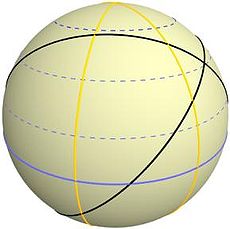Can the Great Circle for Navigation Be Shown Using Drawings

Orthodromic course drawn on the earth world.
Great-circle navigation or orthodromic navigation (related to orthodromic course; from the Greek ορθóς, right angle, and δρóμος, path) is the do of navigating a vessel (a transport or aircraft) forth a bang-up circle. Such routes yield the shortest altitude between two points on the world.[1]
Form [edit]

Effigy 1. The corking circle path betwixt (φ1, λ1) and (φtwo, λ2).
The not bad circle path may exist found using spherical trigonometry; this is the spherical version of the changed geodetic trouble. If a navigator begins at P 1 = (φane,λ1) and plans to travel the corking circle to a point at betoken P 2 = (φ2,λii) (meet Fig. ane, φ is the latitude, positive northward, and λ is the longitude, positive eastward), the initial and concluding courses α1 and α2 are given by formulas for solving a spherical triangle
where λ12 = λ2 − λ1 [note one] and the quadrants of αone,α2 are determined by the signs of the numerator and denominator in the tangent formulas (eastward.g., using the atan2 function). The central bending between the two points, σ12, is given by
- [note two] [note three]
(The numerator of this formula contains the quantities that were used to determine tanα1.) The distance forth the great circumvolve will and so exist s 12 =Rσ12, where R is the assumed radius of the earth and σ12 is expressed in radians. Using the mean world radius, R =R 1 ≈ 6,371 km (3,959 mi) yields results for the distance s 12 which are within 1% of the geodesic length for the WGS84 ellipsoid; meet Geodesics on an ellipsoid for details.
Finding manner-points [edit]
To find the way-points, that is the positions of selected points on the nifty circle betwixt P 1 and P 2, we first extrapolate the great circumvolve back to its node A, the signal at which the bang-up circle crosses the equator in the n direction: let the longitude of this bespeak be λ0 — encounter Fig i. The azimuth at this indicate, α0, is given past
- [note four]
Let the angular distances along the great circumvolve from A to P i and P 2 exist σ01 and σ02 respectively. Then using Napier'south rules nosotros have
- (If φ1 = 0 and αane = ane⁄2 π, apply σ01 = 0).
This gives σ01, whence σ02 = σ01 + σ12.
The longitude at the node is constitute from

Figure 2. The great circumvolve path betwixt a node (an equator crossing) and an capricious betoken (φ,λ).
Finally, calculate the position and azimuth at an arbitrary bespeak, P (see Fig. ii), by the spherical version of the direct geodesic problem.[note v] Napier'south rules requite
- [note 6]
The atan2 function should be used to make up one's mind σ01, λ, and α. For instance, to find the midpoint of the path, substitute σ = 1⁄2 (σ01 + σ02); alternatively to observe the signal a distance d from the starting bespeak, take σ = σ01 +d/R. Likewise, the vertex, the signal on the bang-up circle with greatest breadth, is institute by substituting σ = + i⁄2 π. It may be convenient to parameterize the road in terms of the longitude using
- [notation 7]
Latitudes at regular intervals of longitude tin can be constitute and the resulting positions transferred to the Mercator chart assuasive the dandy circle to be approximated by a series of rhumb lines. The path determined in this way gives the great ellipse joining the end points, provided the coordinates are interpreted as geographic coordinates on the ellipsoid.
These formulas utilize to a spherical model of the earth. They are also used in solving for the bang-up circle on the auxiliary sphere which is a device for finding the shortest path, or geodesic, on an ellipsoid of revolution; see the article on geodesics on an ellipsoid.
Example [edit]
Compute the swell circumvolve route from Valparaíso, φone = −33°, λ1 = −71.vi°, to Shanghai, φ2 = 31.4°, λ2 = 121.8°.
The formulas for course and distance requite λ12 = −166.6°,[note 8] α1 = −94.41°, α2 = −78.42°, and σ12 = 168.56°. Taking the earth radius to be R = 6371 km, the altitude is due south 12 = 18743 km.
To compute points along the route, beginning find α0 = −56.74°, σ1 = −96.76°, σ2 = 71.8°, λ01 = 98.07°, and λ0 = −169.67°. Then to compute the midpoint of the route (for instance), have σ = 1⁄2 (σ1 + σii) = −12.48°, and solve for φ = −half-dozen.81°, λ = −159.18°, and α = −57.36°.
If the geodesic is computed accurately on the WGS84 ellipsoid,[iv] the results are α1 = −94.82°, α2 = −78.29°, and s 12 = 18752 km. The midpoint of the geodesic is φ = −seven.07°, λ = −159.31°, α = −57.45°.
Gnomonic nautical chart [edit]
A direct line drawn on a gnomonic chart would be a great circle track. When this is transferred to a Mercator nautical chart, it becomes a curve. The positions are transferred at a user-friendly interval of longitude and this is plotted on the Mercator nautical chart.
Run across as well [edit]
- Compass rose
- Great circle
- Great-circumvolve distance
- Neat ellipse
- Geodesics on an ellipsoid
- Geographical distance
- Isoazimuthal
- Loxodromic navigation
- Map
- Portolan map
- Marine sandglass
- Rhumb line
- Spherical trigonometry
- Windrose network
Notes [edit]
- ^ In the article on dandy-circle distances, the note Δλ = λ12 and Δσ = σ12 is used. The note in this commodity is needed to deal with differences between other points, due east.k., λ01.
- ^ A simpler formula is
- ^ These equations for α1,α2,σ12 are suitable for implementation on modern calculators and computers. For hand computations with logarithms, Delambre's analogies[ii] were usually used:
- ^ A simpler formula is
- ^ The straight geodesic problem, finding the position of P ii given P one, α1, and s 12, can also be solved by formulas for solving a spherical triangle, equally follows,
- ^ A simpler formula is
- ^ The following is used:
- ^ λ12 is reduced to the range [−180°, 180°] by adding or subtracting 360° equally necessary
References [edit]
- ^ Adam Weintrit; Tomasz Neumann (vii June 2011). Methods and Algorithms in Navigation: Marine Navigation and Safety of Body of water Transportation. CRC Printing. pp. 139–. ISBN978-0-415-69114-7.
- ^ Todhunter, I. (1871). Spherical Trigonometry (3rd ed.). MacMillan. p. 26.
- ^ McCaw, Thou. T. (1932). "Long lines on the Earth". Empire Survey Review. i (6): 259–263. doi:10.1179/sre.1932.1.6.259.
- ^ Karney, C. F. F. (2013). "Algorithms for geodesics". Periodical of Geodesy. 87 (one): 43–55. doi:ten.1007/s00190-012-0578-z.
External links [edit]
- Great Circumvolve – from MathWorld Swell Circle description, figures, and equations. Mathworld, Wolfram Research, Inc. c1999
- Great Circle Mapper Interactive tool for plotting bang-up circle routes.
- Neat Circle Computer deriving (initial) grade and distance between two points.
- Great Circumvolve Altitude Graphical tool for drawing great circles over maps. Also shows distance and azimuth in a table.
- Google assistance program for orthodromic navigation
Source: https://en.wikipedia.org/wiki/Great-circle_navigation















0 Response to "Can the Great Circle for Navigation Be Shown Using Drawings"
Enviar um comentário